The Imperial Ruling Council, known as the Imperial Inner Circle and Emperor's Inner Circle, was a collective body of advisors led by Grand Vizier Sate Pestage that constituted the effective leadership of the Galactic Empire. While Palpatine was Emperor, the Council managed the daily affairs of the Empire and carried out the Emperor's will.
Following the Emperor's death at the Battle of Endor, Pestage took his throne as regent while other Councilors formed a tribunal known as the Emperor's Ruling Circle or Cabal in opposition, and ruled the Empire after the fall of Pestage and his successor, Director of Imperial Intelligence Ysanne Isard. The final death of a reborn Palpatine was orchestrated by a group of conspirators who seized power as the Imperial Interim Ruling Council, but fell to internal conflicts and the depredations of Imperial loyalists.
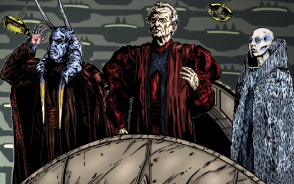
The Ruling Council had its basis in Palpatine's early circle of advisors, such as Mas Amedda and Sly Moore.
In 19 BBY, Galactic Republic Supreme Chancellor Palpatine transformed the Republic into the Galactic Empire. Early in his reign as Galactic Emperor, Palpatine's inner circle joined him to receive reports given by Imperial military advisors, and included Mas Amedda and Sly Moore, who served him as Emperor as they had when he was Chancellor. Shortly after the birth of the Empire, the inner circle established the Imperial Security Bureau, an intelligence agency created to rival the newly-reorganized Imperial Intelligence.
Under the New Order of the Galactic Empire, the Imperial Ruling Council was formed, with old allies of Palpatine's among its appointees, such as ousted Chommell sector senator Janus Greejatus and covert Emperor's Hand Sarcev Quest, the first of many of Palpatine's subordinates in the dark side of the Force to be initiated into the Council. The Ruling Council's head, Grand Vizier Sate Pestage, had taken taken over many of the Empire's daily operations prior to the Battle of Hoth in 3 ABY.
By 4 ABY, the time of the Battle of Endor, the ministers and governors nearest the Emperor had come to be known as the Emperor's Inner Circle, a cadre of Imperial Advisors that included Pestage, Greejatus, Sim Aloo, Kren Blista-Vanee, and Ars Dangor, an ally from Palpatine's time as a senator.
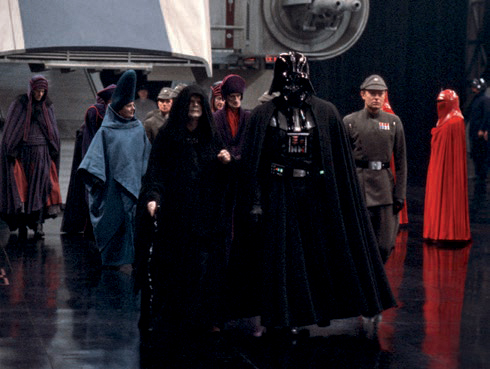
The Emperor's Ruling Circle among Palpatine's retinue on the second Death Star
Members of the Emperor's Inner Circle, Greejatus, Aloo, and Blista-Vanee among them, accompanied their master as his shuttle arrived aboard the second Death Star to spring the trap set for the Rebel Alliance over Endor. However, the Emperor was betrayed and slain by his apprentice, Darth Vader, and all six advisors soon followed when the Rebellion succeeded in destroying the space station.
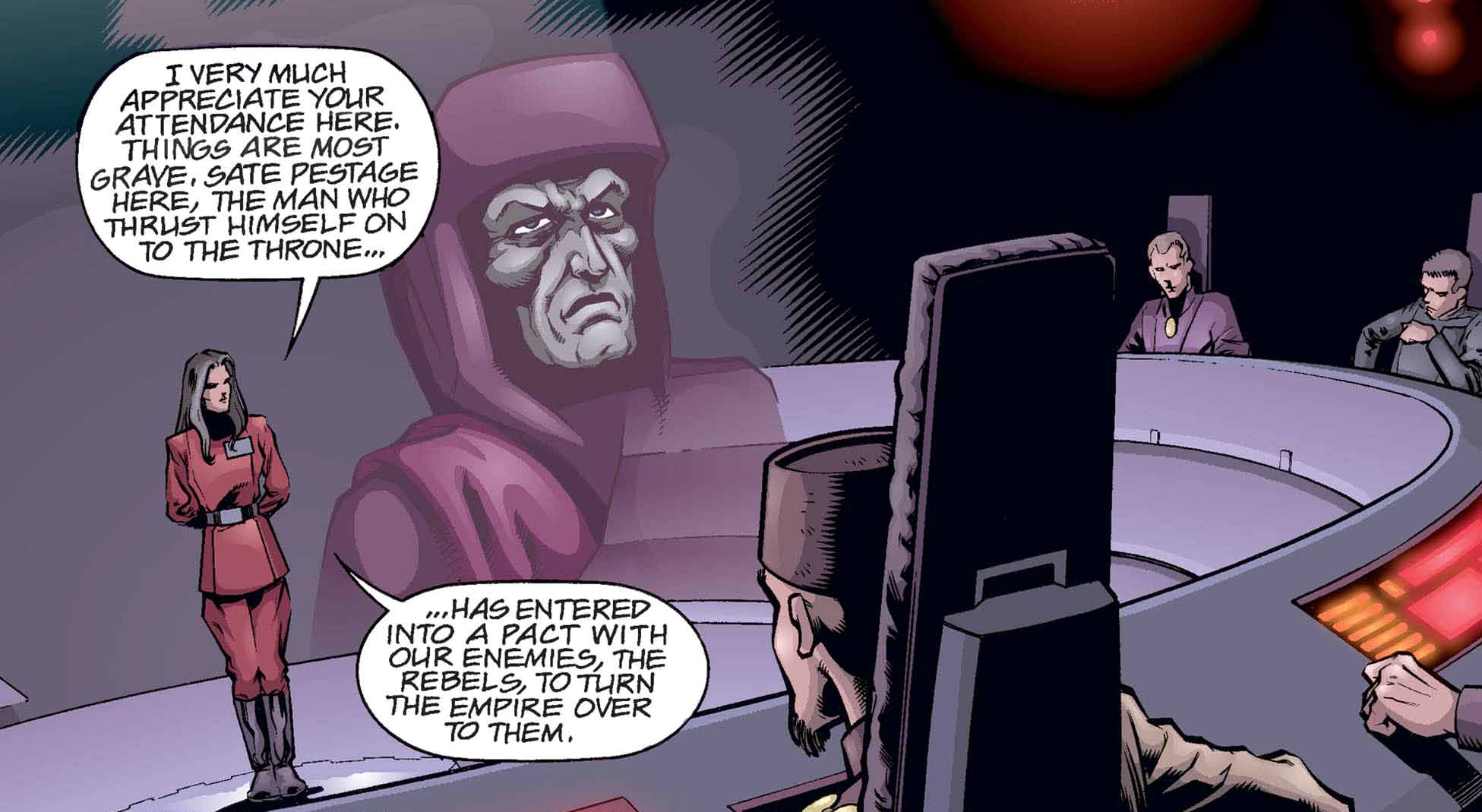
The death of Palpatine split the Council between Grand Vizier Sate Pestage and the Emperor's Ruling Circle.
Though no clear succession plan had been left by Palpatine in the event of his death, Sate Pestage held the best claim to rule, and took control of the Empire as regent. However, lacking his predecessor's charisma and influence, the Grand Vizier was vulnerable to domestic rivals, chief among them a tribunal formed by the fallen Emperor's advisors known as the Ruling Circle, though Pestage labeled them "the Cabal".
Based on Coruscant and led by Ars Dangor, the Emperor's Ruling Circle recalled the Empire's remaining forces to be redeployed in defense of so-called fortress worlds, planets nearly as well-defended as the capital of Coruscant in inner star systems of particular strategic or economic significance, fearing an invasion of the Core Worlds by the Rebellion-turned-New Republic. However, though they feigned continued loyalty to the Empire, prominent figures such as Grand Moff Ardus Kaine of Oversector Outer and Admiral Zsinj of Quelii Oversector ignored the regency's requests, preferring to cement their own powerbases than see their assets divided among the interests of the Ruling Circle. By two years after the Battle of Endor, the Imperial rulers, too preoccupied with internal power struggles to provide effective tactical guidance, had placed the fleet elements responsible for the defense of the Core under the command of Admiral Uther Kermen.
An unsuccessful attempt to seize control over the Empire by the Inner Circle of the Imperial Ruling Council was thwarted by Palpatine's former agent Sarcev Quest, but the conflict between the Grand Vizier and the Council was carefully cultivated by Director of Imperial Intelligence Ysanne Isard. She regarded Pestage and the Council alike as incompetents who had to be removed to ensure the New Order's survival, and so, she played both sides off against each other.
Nine months after Endor, matters came to a head at Brentaal IV, a key military and commercial hyperspace junction in the Core. Neither Pestage nor the Cabal wished to lose the world—the Grand Vizier sought to hold the planet for strategic reasons and to prove himself capable of resisting the New Republic, while leading members of the ERC had important holdings there, and it was home to at least one councilor. But Brentaal was defended by the incompetent Admiral Lon Isoto, who Isard presented to the Grand Vizier as the Cabal's candidate, while persuading leading members of the Council that he was Pestage's man. As Isoto stumbled his way from disaster to defeat, Isard told each side that the other was preventing his replacement by a more competent commander, in the hope of undermining their position.
While the Grand Vizier was astute enough to realize that he had been manipulated by Isard, the Cabal blamed Pestage for his conduct of the war, and some began to openly suggest recruiting warlords such as Blitzer Harrsk and Treuten Teradoc to defend their holdings rather than rely on commanders loyal—as they thought—to the Grand Vizier. Pestage's position was weakened by his loss of Sarcev Quest's support: the former Emperor's Hand believed that the real Grand Vizier had fled and replaced himself on Coruscant with a mentally unstable clone.

The Tribunal under General Paltr Carvin
As Pestage sought to escape Isard's machinations and secure his own control of his fiefdom in the Ciutric Hegemony, Isard presented his actions to members of the Council as treason against the Empire, and called on them to act. With Pestage on the run, the tribunal—now composed of High General Paltr Carvin, the Council's elected leader and commander in the Coruscant Defense Forces , alongside Tribunes Challer and Plumba—seized power, although they were rapidly deposed in turn by Isard herself. Her remaining opponents eliminated, Isard established a dictatorship with herself as Empress in all but name, including a personal escort of the Imperial Royal Guard, while allowing the Ruling Council to persist as a powerless legislative body.

The fall of Coruscant allowed the Ruling Council to return to power on Orinda.
After Isard's loss of Coruscant and her retreat to Thyferra, Dangor and a reformed Ruling Council relocated to the Imperial-held trade world of Orinda, where they once again provided a central authority for the Empire, though their control over its bickering Moffs was tenuous. They supported Grand Admiral Thrawn as Supreme Commander—mistakenly believing that as an alien, and with no standing in their rarified political world, he would necessarily remain beholden to their patronage and government. They considered granting him the title of Emperor if he was successful, still assuming they could control him afterwards; however, even during his campaign he acted largely on his own, stating that he was the sole leader of the Empire.
At this time, New Republic Council Research uncovered rumors of the Imperial Ruling Council's existence and preparations for war; but its director, Voren Na'al, was unable to substantiate them and doubted their probability. Though Orinda fell to the New Republic in the aftermath of Thrawn's death, the Ruling Council were able to build on his successes by driving the Republic from the Core and reconquering Coruscant under the clandestine direction of a reborn Emperor Palpatine, resurrected in a clone body.
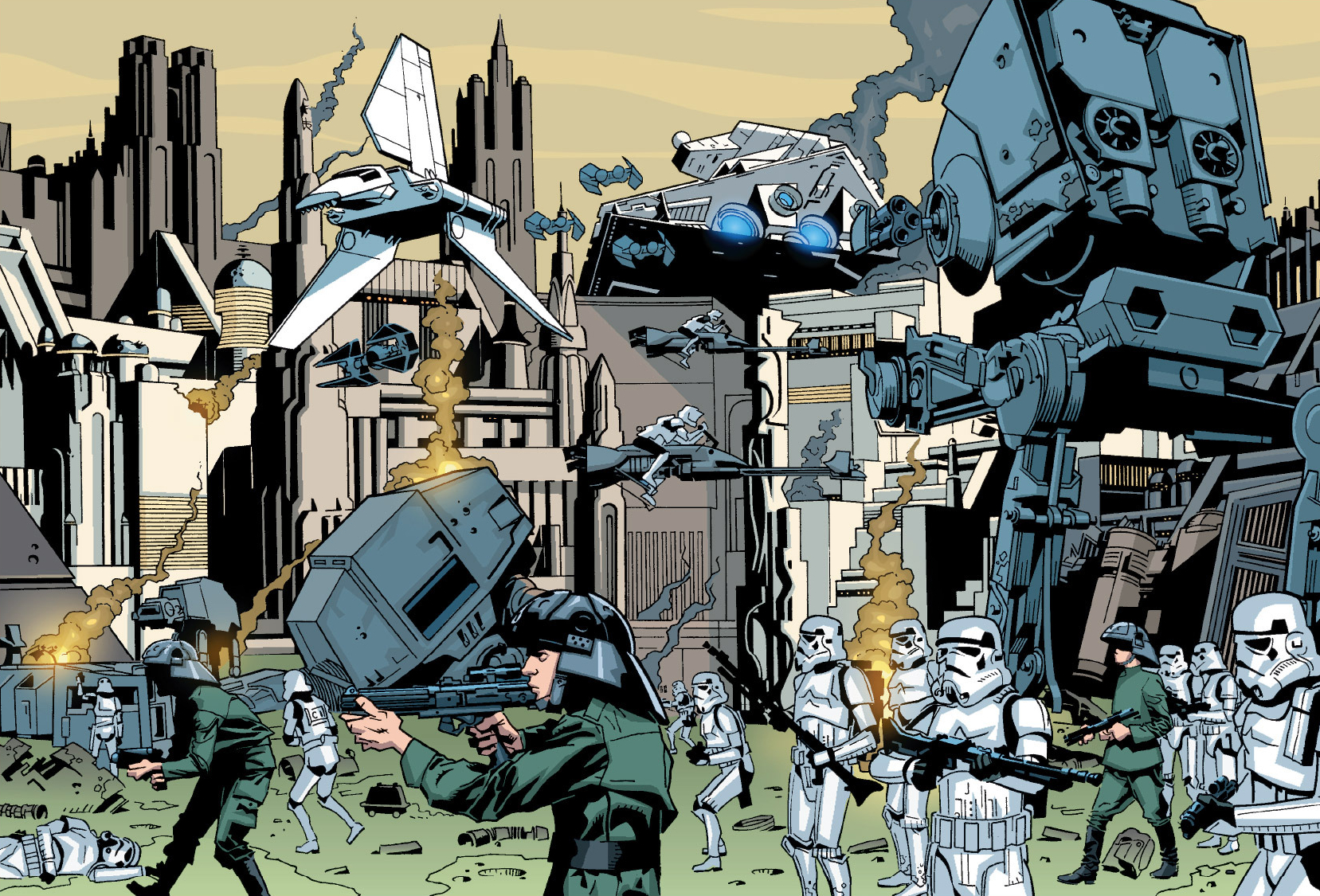
Under Ars Dangor's Ruling Circle, the Empire fell into civil war.
Ars Dangor's suggestion that a new ruler be elected provoked disagreement between the Ruling Council and Moffs on how to proceed, and escalated into a vicious civil war with the Navy, Inquisitorius, COMPNOR, and Imperial Security Bureau. Within the Council itself, Sarcev Quest had been building up support among his fellow Advisors and units of the Imperial Royal Guard to advocate for the leadership of Force-sensitive Guardsman Carnor Jax, Quest's student in the dark side who had been tasked with infiltrating the Imperial leadership by his master, Dark Lady of the Sith Lumiya. Their machinations were interrupted by the reappearance of Palpatine, who made his survival known to the galaxy and assembled a new Dark Empire from the Deep Core safeworld of Byss in 10 ABY.
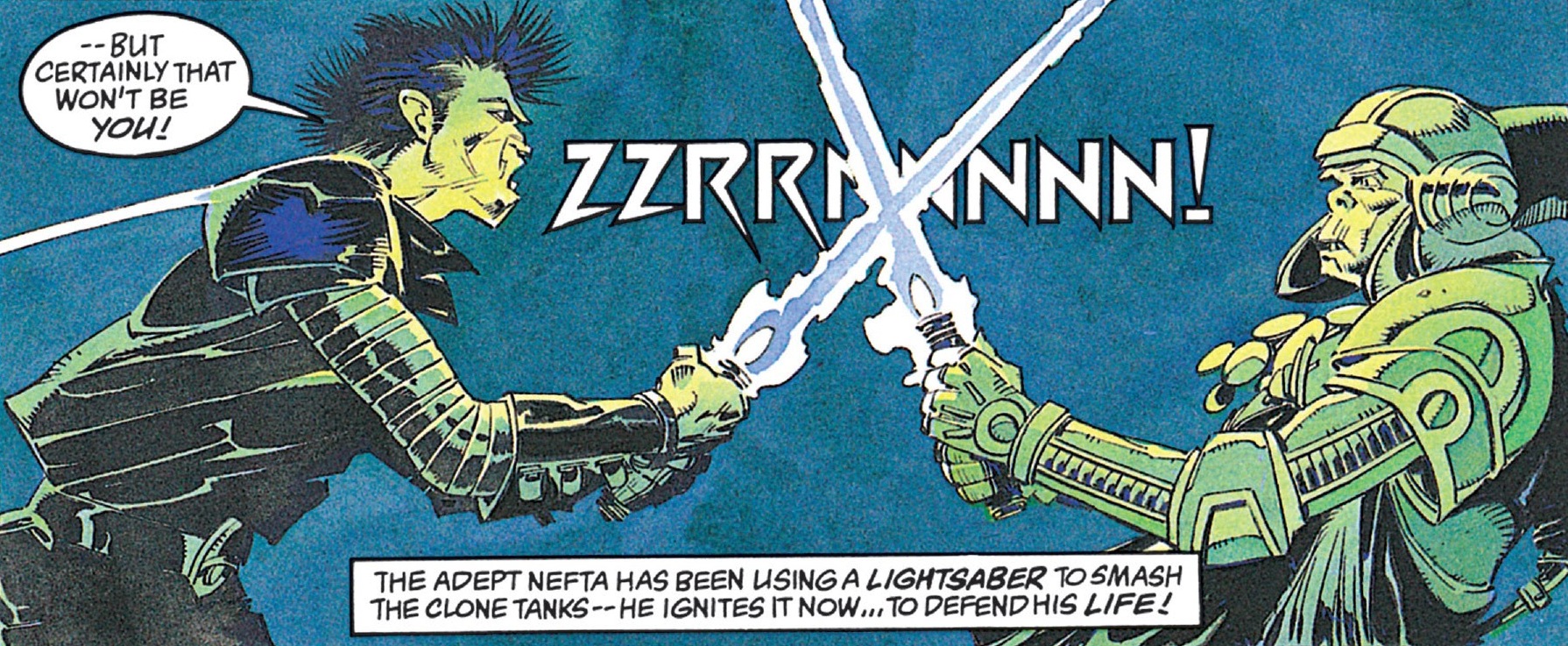
Executor Sedriss defended his Emperor from traitors among the Council.
Though he claimed loyalty to the reborn Emperor, Sarcev Quest was no longer Palpatine's loyal spy among the Advisors, and the Council members were reluctant to surrender the authority they had acquired since Endor—not even to Palpatine. At Quest's urging, the Council lent its patronage to Carnor Jax as a new figurehead for the Empire. Laying the groundwork for a coup, Quest installed Jax as one of the cadre of Imperial Sovereign Protectors who provided Palpatine's personal guard, and, with funds provided by Imperial Ruling Council members, bribed the Emperor's physician to sabotage the genetic material for the clone bodies which were the key to Palpatine's rebirth. At the same time, Quest's rival dark side councilors Nefta and Sa-Di struck openly against the Emperor's clone reserves, only to be slain by the loyalist Executor Sedriss.
Narrowly avoiding exposure by Council members hoping to curry favor with the Emperor, Quest's conspiracy bore fruit, and he and Jax seized control when the Dark Empire was struck a deathblow with the simultaneous destruction of Byss by the misfiring of the Imperial Galaxy Gun superweapon and death of Palpatine's final clone on Onderon,
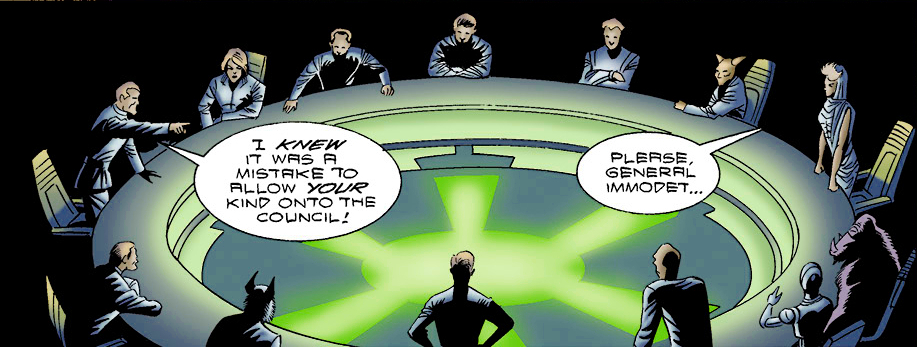
The Interim Ruling Council in session on Ord Cantrell
With the destruction of the Emperor and original Ruling Council, Carnor Jax's confederates formed the Imperial Interim Ruling Council to fill the void in their Lord's Crimson Empire, including, for the first time, non-human members. Lord Jax used his control over the Ruling Council in a bid to assume Palpatine's position, but found his ambitions under threat from the Imperial Royal Guard, who had discovered his part in the death of the Emperor. Jax had them slaughtered, but a sole survivor, Kir Kanos, escaped with knowledge that could bring down both Jax and the Ruling Council. Hunting Kanos on the planets Zaadja, Phaeda, and finally Yinchorr, Jax instead met his end at Kanos' hand in the Squall, the Guardsman's arena where they had once trained alongside each other. The Council quickly turned on Quest, now stripped of Jax's protection, subjecting him to a week of torture before abandoning him on Nar Shadaa, the smuggler's moon.
The Imperial Interim Ruling Council hastily convened at a tower headquarters in the De-Purteen resort on the the planet Ord Cantrell. In reaction to the deaths of Jax and General Redd Wessel, his military director, Councilman Burr Nolyds became the body's acting head, though his tenure was brief. Nom Anor, a representative of the extragalactic Yuuzhan Vong who had once sought an alliance with Jax, had instead joined Council member Xandel Carivus in a plot to usurp Nolyds' leadership. When the acting head was killed in his quarters by a self-destructing message disk, the Ruling Council elected Carivus in his place, believing him to be easily manipulated and an likely target for assassination. Framing Kanos, Jax's killer, for the deaths, Anor's next victim among the Council was Admiral Llon Banjeer. In reality, the Yuuzhan Vong spy had been tasked with hastening the downfall of the Empire, destabilizing the galaxy, and paving the way for his kind's coming invasion.
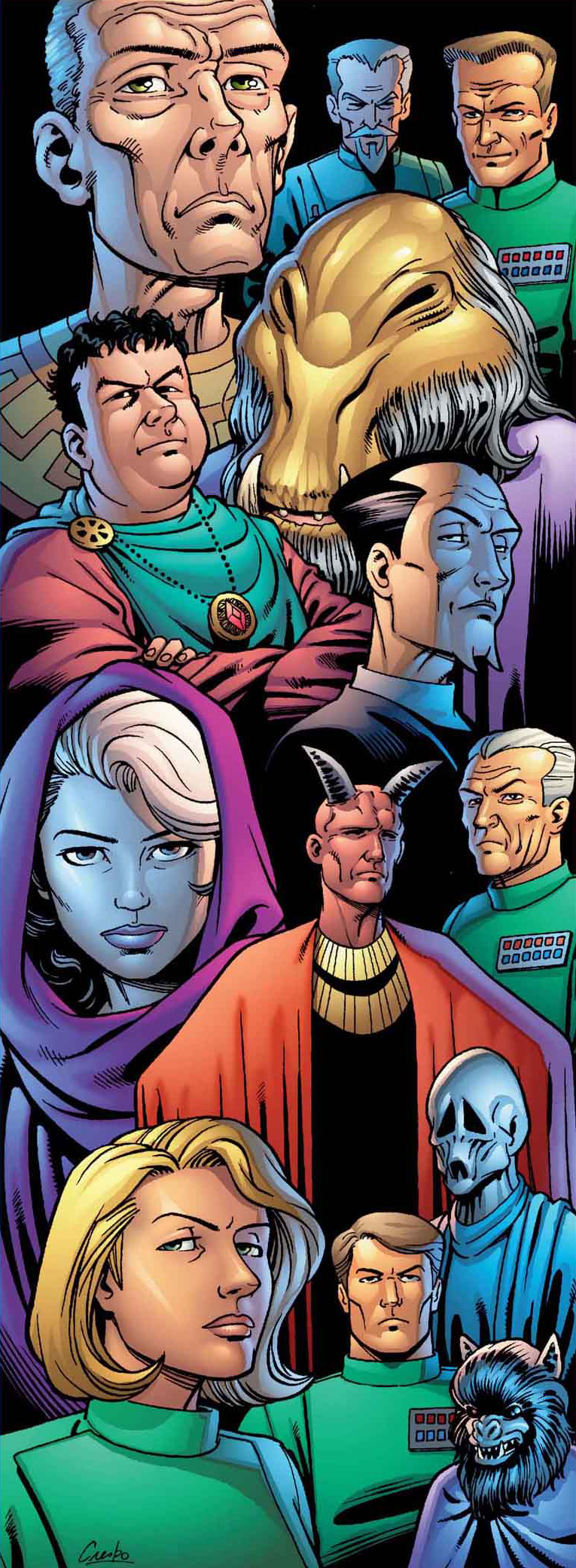
The Imperial Interim Ruling Council members
However, Anor and Carivus were not the only force manipulating the Interim Ruling Council: Feena D'Asta, who had taken the Council seat of her ailing father, vehicle manufacturer Baron Ragez D'Asta, had been abducted by the crime syndicate Black Sun and replaced with a clone four years prior. Acting as their agent on the Council, she advanced their agenda of peace between the Empire and the New Republic. The next death on the Council, that of General Immodet, was orchestrated by the Black Sun and prompted a paranoid Carivus to appoint his own private guard as internal security. Carivus' guard arrested his rival the clone D'Asta and all non-human Councilors, killing Spearmaster Ch'Unkk when the Whiphid attempted to resist. Black Sun's conspiracy was revealed to the Council following an unsuccessful attempt to substitute Carivus himself for a clone, adding to the threats posed by the New Republic, potential reprisal from forces loyal to D'Asta and Ch'Unkk, and Carivus' falsified attacks by Kanos, and generating concern among the remaining Councilors. In turn, Carivus dismissed the services of Nom Anor and declared himself Emperor, disbanding and jailing the Council.
Emperor Carivus stood alone against Baron D'Asta, who launched an assault on Ord Cantrell in retribution for his daughter's imprisonment. With his Empire's forces spread too thin, Carivus released the clone Feena in exchange for a cease of hostilities. However, the Baron was also contacted by New Republic Commander Mirith Sinn, who had liberated the genuine Feena D'Asta and Kir Kanos from the palace of Black Sun-affiliate Grappa the Hutt. Though Kanos sought the death of the clone for her unwilling role in the assassination of Palpatine, Sinn redirected his attentions to Carivus. Using a private audience between the Baron and Emperor as cover, Kanos slew Carivus, though he spared the former Councilors he had held prisoner. After less than a year, the Crimson Empire had collapsed, taking with it the Imperial Ruling Council and the last vestiges of centralized Imperial control.
In 13 ABY, surviving Councilors Ragez and Feena D'Asta allied themselves with the Imperial Remnant, a confederation of former warlord holdings under the leadership of Grand Admiral Thrawn's protegé Admiral Gilad Pellaeon and governed by the Council of Moffs. Opposing the Moffs, the D'Astas pushed Pellaeon towards peace with the New Republic, a stance that resulted in Feena's death at the hands of a faction of Imperial hardliners.
Following his betrayal by and ejection from the Imperial Ruling Council, Sarcev Quest went into hiding, making his way from Nar Shadaa to the Core, where he paid for passage aboard a luxury liner to seek refuge in the Corporate Sector. However, Quest was subject to a price placed on his head by Jeng Droga, another former Emperor's Hand, and he was captured by Ailyn Vel, bounty hunter and estranged daughter of the legendary Mandalorian Boba Fett. Taking vengeance on the traitorous Quest, Droga executed his one-time fellow in 23 ABY.
The Emperor's Inner Circle served as advisors to Palpatine. Its members, several of whom were human males with pale skin and sunken features, wore purple- and burgundy-colored robes and elaborate headwear. Many of the Circle's number played significant roles in the Imperial bureaucracy, particularly Sate Pestage and Ars Dangor, who each found much of the day-to-day management of the Empire in their hands. On the fortress world Byss, the Emperor and the darksiders of his inner circle developed the immense subservient clone warriors known as Imperial Sentinels, while in the wider galaxy the inner circle relied on trusted agents such as Wullf Yularen of the Imperial Security Bureau. The advisors of the inner circle were disdained by the Emperor's apprentice Darth Vader as self-important and petty, preoccupied with enriching themselves and gaining prestige. Initially, Palpatine's inner circle included Sly Moore and Mas Amedda, aliens who had served him in his Republic office. However, humanocentrism was pervasive in the Empire, and the Imperial Council would not include alien members until the Emperor's final death in 11 ABY.
Led by Pestage as Grand Vizier, the Imperial Council was responsible for the live broadcast of holodocumentaries such as Life on Tatooine, aired during the blockade of the Wookiee planet Kashyyyk and conceived to reinforce the loyalty of the Imperial citizenry through comparison of their own lives to the suffering of others. Prior to his defeat at Endor, many of Palpatine's Dark Side Adepts were inducted into the Imperial Ruling Council, a move towards the Emperor's vision of a Dark Side Theocracy taking the place of the Empire's secular bureaucrats. Imperial captain Zeta Traal sought to be rewarded with a seat on the Council for her capture of the Rebel Jedi aspirant Luke Skywalker.
With Palpatine's death at Endor, the Imperial Ruling Council rose to power over the remnants of his dominion, struggling to restore its control over the galaxy. The members of this Council were internally addressed as tribunes, and as lords by even highly-placed Imperial outsiders. While Pestage took the throne, his rivals formed the Emperor's Ruling Circle, a significant force under Dangor's leadership. The Imperial Ruling Council's power was sapped by Pestage's successor Ysanne Isard, but regained some of its authority when it was resurrected under Dangor on Orinda after her fall, which he invested in Grand Admiral Thrawn, and would later allow his Council to retake Coruscant and subsequently call for the election of a new Emperor from their number.
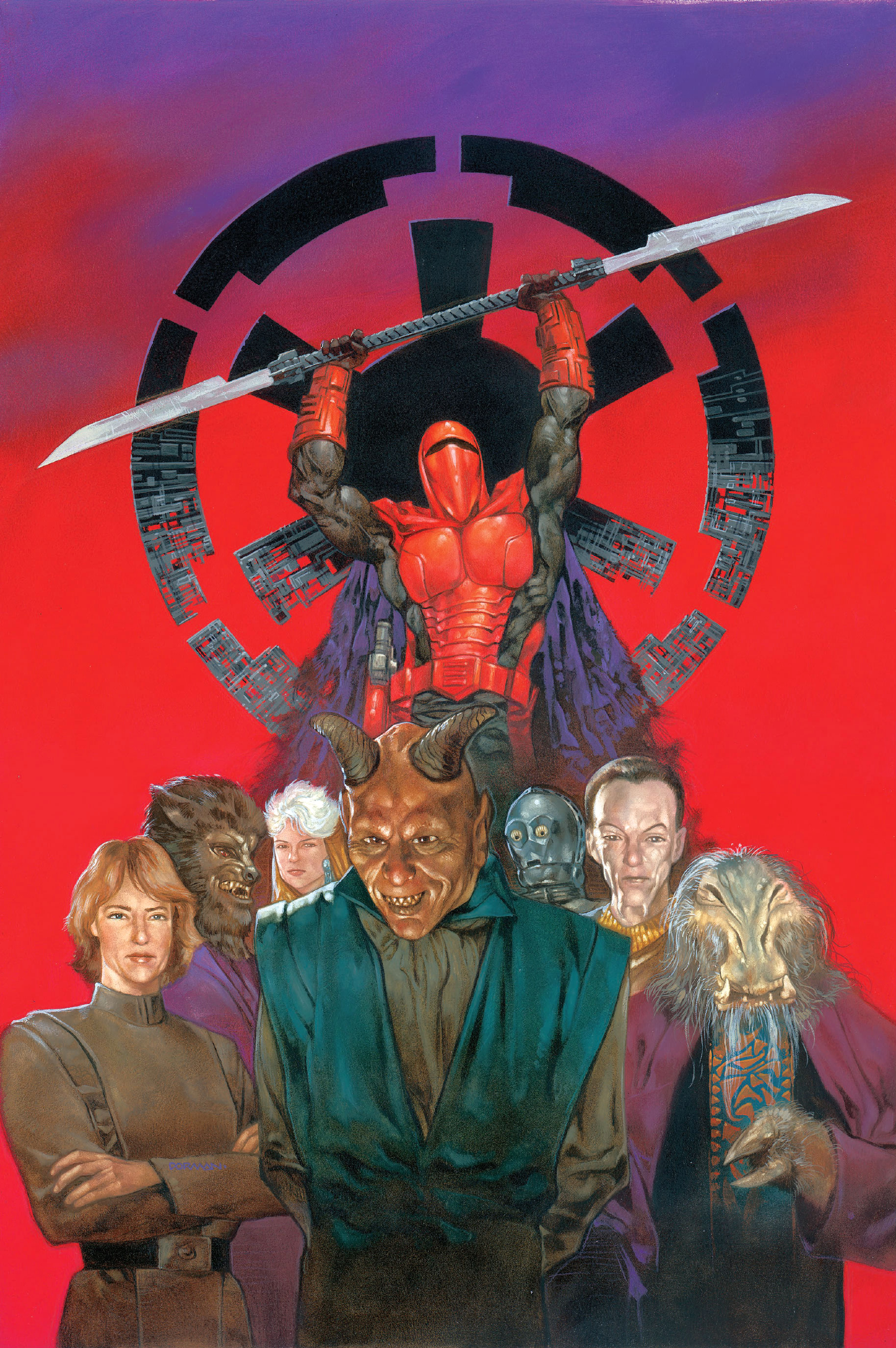
The Imperial Ruling Council included alien members for the first time under the Crimson Empire.
When he took the throne, Lord Carnor Jax assembled the military, political, and economic figures who had been his co-conspirators and benefactors into the Imperial Interim Ruling Council, including the aristocratic Burr Nolyds, conniving bureaucrat Xandel Carivus, callous tactician Admiral Jeratai, media mogul Mahd Windcaller, and Tann Starpyre, representative of the Diet of Imperial Planetary Governors who maintained a veneer of democracy within the Empire. The presence of non-humans, such as the Whiphid clan leader Ch'Unkk, Devaronian union-lord Manos, Myke warlord Norym Kim, Defel Prince Za, and the Givin Kooloota-Fyf of the Shipbuilders and Astromechs Guild, granted status on the Council to ensure the cooperation of their constituents, created internal friction with more traditionalist Councilors. The false Feena D'Asta spoke for her supposed father, ailing Ragez D'Asta of the D'Astan sector and private fleet, while the Imperial Army and Navy had presence on the Council in the persons, respectively, of General Immodet and Admiral Banjeer. Sarcev Quest abused Jax's protection to reign in tyranny over his fellow councilors, striking against any potential rivals among them.
The Imperial Ruling council was first mentioned as the "Imperial Council" in 1978's The Star Wars Holiday Special, and made their first appearance in James Kahn's 1983 novelization of Star Wars: Episode VI Return of the Jedi.
The name "Emperor's Ruling Circle" was first used in the 1991 first issue of Dark Horse comic book series Dark Empire, and "Imperial Ruling Council" in West End Games' 1992 Dark Force Rising Sourcebook. Though the Ruling Council was described only as a pre-Battle of Endor entity, in contrast to the post-Endor Ruling Circle, Dark Horse's 1997 comic Crimson Empire 1 introduced a later incarnation of the Ruling Council, and the article The Emperor's Pawns of the 2001 magazine Star Wars Gamer 5 equated the three groups.
The Imperial Interim Ruling Council's numbers have been depicted inconsistently between various sources. In the Crimson Empire series of comics, the Council is shown to have thirteen members both human and alien, with a fourteenth, Sarcev Quest, introduced in The Emperor's Pawns. 2008's The Complete Star Wars Encyclopedia indicated that the body consisted of thirteen Imperial loyalists in addition to a further number of non-human councilors, while in 2009 The Essential Atlas claimed that the Council had only twelve members.